Under federal tax law, individuals may deduct the income and property taxes that they pay to their state and local governments, as well as any interest they receive from owning state or local bonds, from their total income when filing their federal taxes. In recent years, individuals have been allowed to choose between deducting their income tax or sales taxes.[REF] Because federal tax deductions effectively spread the costs of these deductions across all taxpayers in the form of higher federal tax rates, the state and local tax deduction results in federal taxpayers in low-tax, low-debt states subsidizing taxpayers in high-tax, high-debt states. Distributional impacts within states results in low-income residents subsidizing high-income residents as a result of these deductions.
If the state and local tax and bond interest deductions were eliminated, federal income tax rates could be reduced by as much as 16.4 percent. Ending the federal subsidy of state and local taxes and debt would help to improve the fiscal discipline and economic efficiency of state and local governments because taxpayers would no longer receive a refund for part of the taxes they paid to their state or locality. Instead, they would pay the full cost of the services they received. Additionally, municipal bond investors would no longer receive a subsidy on top of the interest earned from their municipal bonds, so state and local government budgets would have to reflect the full cost of any accumulated debt.
Economics of the Deductions
Tax deductions reduce the tax base and thus require higher marginal tax rates to maintain the same level of tax revenue. Ideally, deductions should be kept to a minimum after the appropriate tax base has been established. Yet the U.S. tax code is littered with numerous deductions and exemptions. The federal deductions for state and local taxes and municipal bond interest turn high-tax and high-debt states as well as high-income taxpayers into those special interests.
Since state and local taxes reduce individuals’ after-tax income, it may make sense to exclude the income used to pay those taxes from federal taxation. But this was when state and local governments provided the majority of services and collected the majority of taxes. The reverse is true today as the federal government collects over 50 percent more in revenues than state and local governments combined.[REF] As the primary revenue collector, the federal government should not exempt any clevels of taxation. Moreover, the tax deduction allows states to raise taxes higher than they otherwise would and encourages governments to provide services that are more appropriately left to the private sector. The tax deduction also has significant perverse distributional impacts, redistributing income from the poor to the rich, and from people in low-tax states to people in high-tax states.
Size of State and Local Tax and Municipal Bond Interest Deductions
The deductions for state and local taxes and municipal bond interest remain some of the largest deductions in the federal tax code. According to The Heritage Foundation’s Individual Income Tax Model (HFIITM), the state and local tax and municipal bond interest deductions will reduce federal tax revenues by an estimated $128 billion in 2017, rising to $207 billion by 2026, for a total of $1.669 trillion over 10 years. This makes these state deductions among the largest “tax preference” items.
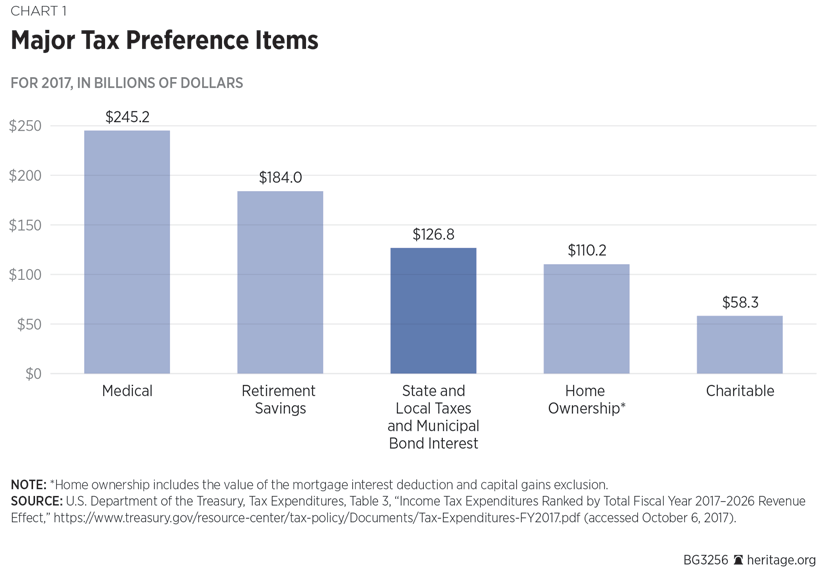
Beneficiaries of State and Local Deductions
States with High Taxes. States with higher income and property taxes receive the greatest benefit from the state and local tax deduction. Seven states receive 53 percent of the value of the state and local tax deduction: California, Connecticut, Illinois, Maryland, Massachusetts, New Jersey, and New York.[REF] On average, taxpayers who itemize in those states deduct 7.6 percent of their income in state and local taxes, compared to 4.2 percent of income among other taxpayers who itemize in all other states.[REF]
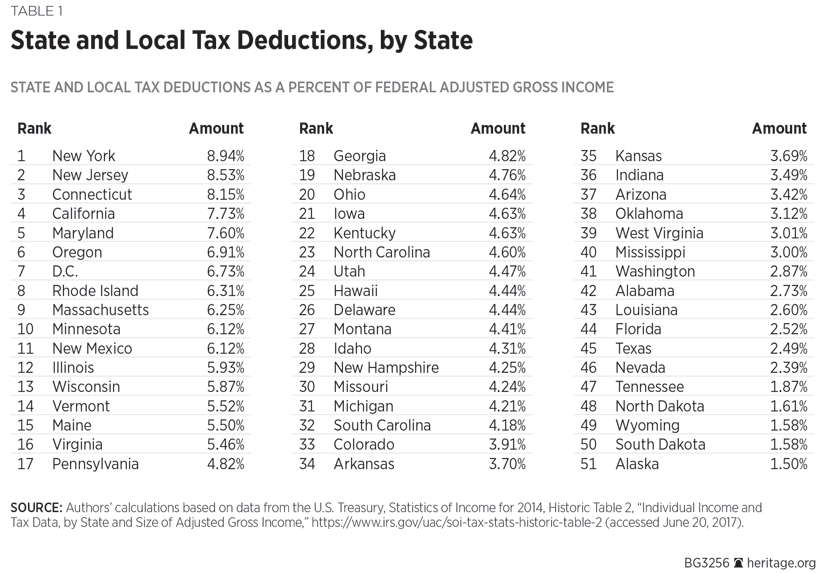
The state and local tax deduction effectively reduces states’ marginal tax rates, allowing them to collect higher taxes while pushing some of the burden from their own taxpayers to taxpayers in other states. For example, the State of California has a top marginal tax rate of 13.3 percent for its highest-income earners, but the state and local tax deduction reduces this to an effective tax rate of 8.0 percent. This is because the federal government effectively reimburses California’s highest-income state taxpayers 40 cents of each dollar they pay in state taxes. Thus, while California’s government keeps every dollar of state tax revenue, only part of that revenue comes from California residents. The rest comes from the federal government in the form of reduced federal tax receipts.
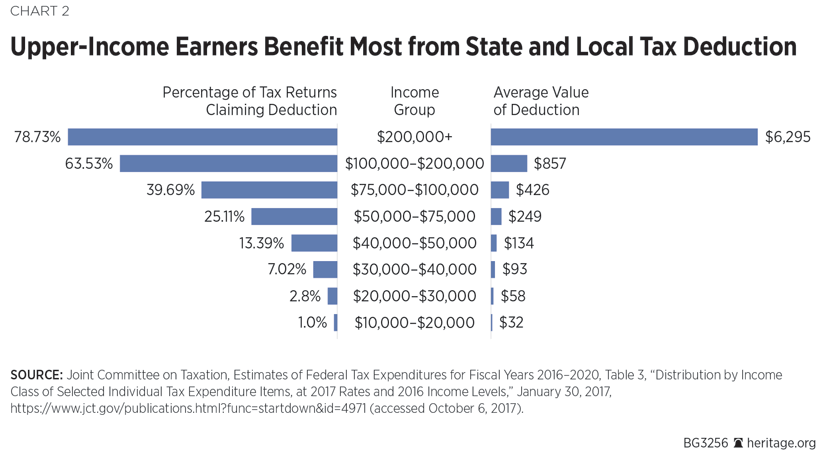
Higher-Income Taxpayers and Itemizers. The deduction for state and local taxes creates winners and losers within states. Higher-income taxpayers win; lower-income taxpayers lose.
The state and local tax deduction is available only to taxpayers who itemize their deductions: for 2017, single taxpayers with more than $6,350 in total deductions and married taxpayers with more than $12,700 in deductions. Thus, more than 70 percent of all taxpayers receive no benefit from the state and local tax deduction. Those who receive no benefit tend to have lower incomes. Only 20 percent of taxpayers making less than $50,000 itemize their deductions, compared with 93 percent of taxpayers who have incomes of $200,000 or more.[REF]
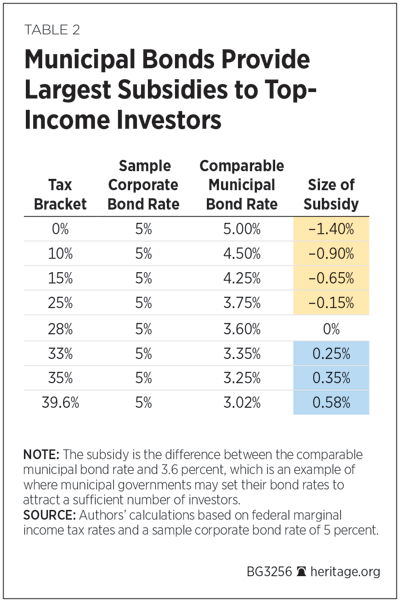
The distribution of the value of the state and local tax deduction is even more skewed than that of those claiming it. According to a 2013 report by the Congressional Budget Office (CBO), 80 percent of the value of the state and local tax deduction goes to the top 20 percent of taxpayers.[REF] This is because higher-income individuals not only pay more state and local taxes, but also face higher marginal tax rates at the federal level. A $10,000 deduction for a middle-income family facing a top federal income tax rate of 15 percent produces a $1,500 reduction in their federal taxes while a $10,000 deduction for a high-income family that faces a 39.6 percent federal income tax rate nets them $3,960.
High-Debt State and Local Governments. The deduction for municipal bond interest drives down the cost of borrowing money for state and local governments. When investors do not have to pay taxes on municipal bonds, they are willing to accept significantly lower interest rates than they would require if they were taxed on those bond purchases. Thus, state and local governments look to finance any eligible spending through municipal bonds because they can then shift a significant portion of the financing cost of that spending onto federal taxpayers (who ultimately pay higher rates in the long run as a result of the lost revenues from the deduction) and it allows them to shift the burden of current spending onto future taxpayers and lawmakers.
Excessive debt financing has been a prime source of municipal bankruptcies across the country. Mounting municipal bankruptcies will certainly place pressure on Congress for a federal bailout. Already, Congress intervened in the debt-ridden and economically depressed territory of Puerto Rico in 2016. Although Congress stopped short of providing cash outright to Puerto Rico, it violated the rule of law by revoking bondholders’ rights to due process and by providing a super-bankruptcy process that the law explicitly prohibited for Puerto Rico.[REF]
High-Income Investors. Like the state and local tax deduction, the municipal bond interest deduction is more valuable to high-income taxpayers who face higher marginal tax rates. Thus, the municipal bond deduction effectively shuts low-income and middle-income investors out of the municipal bond market. Because of the higher value of the deduction to high-income investors, municipalities can reduce interest rates to a level at which it does not make economic sense for low-income investors to purchase them.
If the going rate for a corporate taxable bond is 5 percent, the equivalent rate for a tax-free municipal bond varies between 3 percent and 5 percent, depending on a taxpayer’s marginal tax rate. For example, if a taxpayer in the 39.6 percent bracket purchases a private bond that pays 5 percent interest, he has to pay 2 percent of that interest in federal taxes (2 percent = the 39.6 percent tax rate times the 5 percent interest payment), leaving only 3 percent as after-tax income. However, a taxpayer in the 10 percent bracket would only have to pay 0.5 percent of that interest in federal taxes (0.5 percent = the 10 percent tax rate times the 5 percent interest payment), leaving 4.5 percent as income.
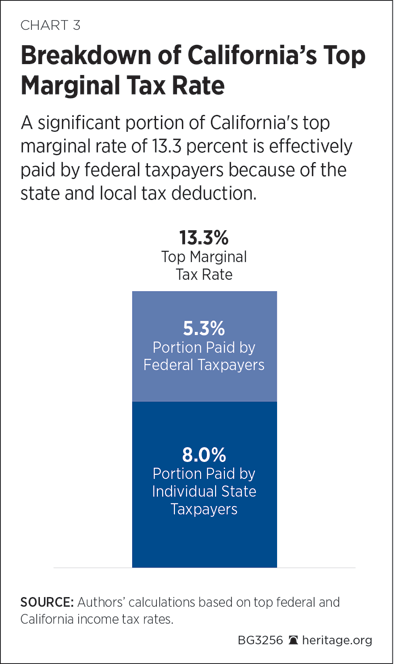
Since state and local governments want to attract more than just investors in the top marginal tax bracket, they have to pay a rate higher than 3 percent (e.g., 3.5 percent or 3.75 percent). This means that investors in the top marginal brackets receive higher interest payments than they require to get them to purchase municipal bonds. Instead of the subsidy going to state and local governments for infrastructure and investment, then, a sizeable portion goes to high-income investors. The CBO estimated that 20 percent of the value of municipal bond deduction goes to high-income households;[REF] another study estimated that a significantly higher portion—about 70 percent to 90 percent—goes to high-income households.[REF]
Tax Deduction Subjects Federal Tax Revenues to the Whim of State Governments
Dependence on state tax policy leaves the federal government with less control over its collection of taxes. By allowing individuals to deduct the taxes paid to their state and local governments, federal revenues become contingent on states’ level of taxation and debt issuance. If states raise taxes or issue more debt (particularly at higher interest rates), individuals deduct more in state and local taxes and interest and federal tax revenues decline. On the other hand, if states lower their taxes or reduce their debts (or interest rates fall), individual deductions decline and federal tax revenues rise.
For example, Illinois’ recent temporary tax increase, contained in Illinois’ Taxpayer Accountability and Budget Stabilization Act, are estimated to have generated an additional $25.7 billion in tax revenues for the state between 2011 and 2014.[REF] However, those same tax increases directly reduced federal tax revenues. Although the exact amount by which federal revenues declined is unknown, it was almost certainly billions of dollars.[REF]
Municipal Bond Interest Deduction Distorts Infrastructure Investment Decisions
The municipal bond interest deduction has long been cited as necessary for state and local governments to invest in infrastructure. However, the exemption can encourage inefficient and excessive levels of infrastructure and other spending by allowing states to issue more debt at a lower cost than they would otherwise.
Because local governments do not bear the full borrowing costs for infrastructure projects financed by municipal bonds, this federal preference incentivizes localities not only to overspend on infrastructure but also to fund projects whose total costs (some of which are not borne by the locality) outweigh their benefits.[REF] Voters tend to view municipal bond financing as “free money” for infrastructure, despite high levels of local debt that foist the financial burden of projects on future generations. In the 2016 election, voters approved 86 percent of municipal bond issuances for transportation infrastructure projects, whereas just 7 percent of measures to increase gas taxes to pay for such projects succeeded.[REF]
The exemption leads taxpayers and local governments to subsidize private projects under the guise of generating economic development or other questionable justifications. For example, 36 professional sports stadiums received tax-exempt municipal bond financing since 2000, amounting to a $3.2 billion subsidy to the issuers and $3.7 billion in lost federal revenues.[REF] Despite justifications that the projects contribute to economic growth, numerous studies have shown that publically funded sports stadiums have no significantly positive, and often a negative, economic effect for metropolitan areas.[REF] Overall, of the $430 billion in municipal bonds issued in 2014, 19 percent ($82 billion) were for private activities.[REF]
Furthermore, the tax exemption for municipal bonds discourages private infrastructure investment, which produces numerous benefits for users and governments, such as improved infrastructure management, fewer project delays, increased economic efficiency, and mitigation of taxpayer risk.[REF] The municipal bond deductions create an artificial inequity that leads local officials and detractors of private infrastructure to incorrectly declare that government can deliver an infrastructure asset more affordably because of lower financing costs, and thus cuts off opportunities for some private infrastructure projects.
This preference has left America far behind other nations (almost all of which do not have similar tax exemptions) when it comes to the provision of private infrastructure.[REF] For example, the U.S. has just one private airport,[REF] whereas partially or completely privatized airports serve nearly 75 percent of European commercial air traffic.[REF] While private investment in surface transportation is growing in the U.S., the majority of large private highway projects take place elsewhere.[REF] Private infrastructure investment around the globe, especially in Europe, Canada, and Australia, continues to outpace that of the U.S.[REF]
Eliminating the State and Local Tax Deduction
The Heritage Foundation’s Center for Data Analysis estimated the static impact on federal tax revenues of eliminating the state and local tax deduction and municipal bond deduction using the HFIITM. The HFIITM estimates the static impact of changes in federal-tax policy on the overall revenues and distribution of federal taxes. A detailed documentation of the HFIITM can be found in the Appendix.
We estimate that eliminating the state and local tax deduction would increase federal income tax revenues by about 7.4 percent ($1.669 trillion) over the next 10 years (2017–2026). The Treasury Department estimates a very similar revenue effect of $1.692 trillion over the same period.[REF]
Replacing the Deduction with Reduced Rates. The purpose of eliminating the state and local tax and municipal bond interest deductions is not to generate new federal tax revenues, but to rid the tax code of inefficient policies. Thus, Congress should offset the removal of any deductions with a reduction in marginal tax rates. Our first simulation uses the revenues from eliminating the state and local tax and municipal bond interest deductions to lower rates in a way that maintains both revenue neutrality and distributional neutrality with the current tax code. Based on the results, revenue neutrality in the final year (2026) is maintained within 0.08 percent of the current baseline revenues and distributional neutrality is within an average of 0.07 percentage points of current baseline tax shares.[REF]
In our revenue-neutral and distribution-neutral rate-reduction scenario, the largest tax reductions would go to the 25 percent and 28 percent tax brackets, which would decline by 12.1 percent and 16.4 percent, respectively (to 21.97 percent and 23.42 percent). The 15 percent and upper-income rates would all decline between 3.1 percent and 7.2 percent.
We also analyzed a revenue-neutral scenario focused on reducing tax rates for middle-income individuals and families by reducing the 15 percent, 25 percent, and 28 percent tax rates.[REF] Focusing on these three rates allowed for reductions ranging from 10.7 percent to 16.0 percent. The 15 percent, 25 percent, and 28 percent rates fell to 13 percent, 21 percent, and 25 percent, respectively.
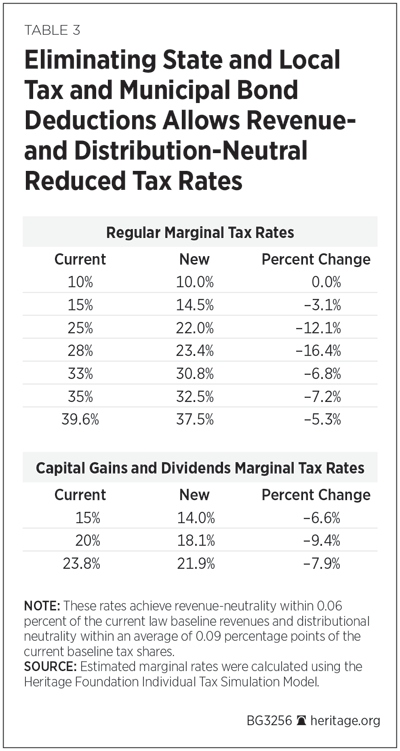
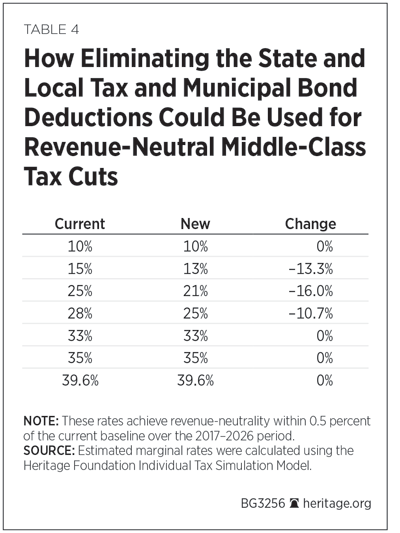
Although we did not dynamically model the macroeconomic effects of replacing the state and local tax and municipal bond interest deductions with lower marginal income-tax rates, such a policy could generate positive macroeconomic impacts. The state and local tax and municipal-bond interest deductions encourage adverse economic policies at the state level and unjust subsidies, so eliminating them could reduce the negative effects of bad state policies and investment-market disruptions. If accompanied by more efficient state tax-and-spending policies, replacing the state and local tax and municipal bond interest deductions with lower federal tax rates would spur economic growth.
The Potential Impact on State Policies
Eliminating the state and local tax deduction could increase accountability in state governance and reduce wasteful spending.
Without the federal government picking up a piece of their state and local tax burden, many taxpayers would face a significantly higher effective state tax burden that could drive some individuals and small businesses (that file taxes as individuals as opposed to corporations) out of high-tax states and into low-tax states. This competition in state taxation would benefit individuals and businesses because it would make states more accountable for all of the tax revenue they collect.
Increased accountability would lead to more equitable and efficient taxation at both the state and federal level. Absent the deduction, taxes would be distributed more equitably according to services received. When faced with the full cost of services received, taxpayers would likely demand fewer services and a more efficient allocation of their tax dollars, leading to a more optimal overall level of taxation.
Eliminating the municipal bond interest deduction would force state and local governments to pick up the full tab of their infrastructure spending (including some private infrastructure projects), instead of allowing them to pass a significant portion on to federal taxpayers. This would help prevent infrastructure spending in which the benefits do not outweigh the costs and it would significantly reduce the practice of turning private infrastructure projects into public ones. Removing the deduction would also encourage more private investment and also level the playing field for the municipal bond market by removing regressive subsidies that disproportionately benefit wealthy investors.[REF] This could help prevent state and local governments from incurring excessive and unnecessary debts that are increasingly contributing to municipal bankruptcies across the U.S.
The Effect on Individuals
Eliminating the deduction may seem like an increase in federal taxes (or an increase in effective state taxes) for anyone who claims the state and local tax deduction, but in fact, it could reduce many of these taxpayers’ federal-tax liabilities. If coupled with a corresponding revenue-neutral and distribution-neutral reduction in federal marginal tax rates, more than 70 percent of taxpayers who do not itemize would face lower combined federal and state income-tax burdens. Additionally, some taxpayers who itemize but who have relatively lower incomes or live in lower-tax states would also experience a tax cut.
In addition to the immediate change in federal tax liabilities, eliminating the state and local tax deduction could cause state and local governments to reduce their taxes as residents would be more likely to push back against high levels of taxes and services if they had to pay the full freight.
End the Subsidy for High-Tax and High-Debt States
An appropriate tax base makes most tax deductions and exclusions inefficient because they require higher marginal-tax rates. The state and local tax deduction fits this description because it supports high levels of taxation and inefficient and wasteful government spending. Furthermore, it subjects federal-tax revenues to the whim of state governments, while benefiting wealthy taxpayers and high-tax states. Meanwhile, the municipal-bond interest deduction encourages inefficient and often excessive levels of infrastructure and publicly supported private investments and it unjustly subsidizes high-income taxpayers.
Eliminating the state and local tax and municipal bond interest deductions would encourage a more efficient tax system, and a corresponding reduction in marginal federal income-tax rates could boost economic growth. As Congress and the President work to achieve pro-growth tax reform, eliminating the state and local tax and municipal bond interest deductions should be at the top of the to-do list.
—Rachel Greszler is Research Fellow in Budget, Economics and Entitlements in the Thomas A. Roe Institute for Economic Policy Studies, at The Heritage Foundation. Kevin D. Dayaratna, PhD, is Senior Statistician and Research Programmer in the Center for Data Analysis, of the Roe Institute. Michael Sargent is a Policy Analyst in the Roe Institute.
Appendix
The Heritage Foundation’s Individual Income Tax Model (HFIITM) is a statistical microsimulation model coded in MATLAB used for forecasting the revenue effects of tax policy reforms and their various manifestations. The model uses data from the 2007 Statistics of Income Public Use Tax File from the Internal Revenue Service.[REF] This stratified sample of the American population consists of approximately 143,142 tax-filing records. The data blur certain information, such as state of residency, for high-income tax filers (those with adjusted gross incomes over $200,000).
The model and data are based on the IRS’s 2007 Form 1040 and include most variables, or lines, contained in this form. Some lines are excluded from the IRS dataset and therefore cannot be disaggregated within the model.
To establish a base-case scenario, the HFIITM model generates an independent and identically distributed random sample from the original 2007 dataset and uses this random sample to “age” each observation of data in subsequent years through 2026. The sample from the original 2007 data is used to generate subsequent observations of data for 2008, and then the 2008 data are used to generate 2009 data, and the process continues.
Each random sample consists of one million observations. Each time an alternative scenario is tested or “scored” by the model, a new base-case scenario is developed. Due to the large sample size of one million observations, the base-case scenario does not differ significantly from one run to another.
The aging of the data from 2007 to 2026 includes targeted aging based on actual data available from the IRS through 2012 and applied growth rates. For nearly all variables, additional aggregate IRS data from 2012 are used to apply a steady growth rate between 2007 and 2012. Beyond 2012, variables are grown according to what are deemed appropriate growth rates.
For example, variables related to income are grown according to presumed income-growth rates, and education-related and health-related tax components are grown according to their estimated cost growth. The tax parameters for 2015 and beyond are adjusted for inflation and income as determined by current tax law. Aggregate revenues are computed using the law of large numbers, which states that for a sufficiently large sample size, the mean of a random sample converges to the population mean.[REF]
Although cyclical growth is expected, the HFIITM—like most other microsimulation models—does not attempt to model such cyclical growth. Instead, the HFIITM assumes steady state growth. Because of this assumption of steady state growth, additional aggregate data from 2012 were used to adjust the growth rates of most variables between 2007 and 2012. Without this adjustment, the estimated growth rates create significantly higher values for many of the variables than actually occurred.
The first simulation using the HFIITM ran a baseline scenario based on current policy and juxtaposed this against an alternative scenario that eliminates state and local tax deductions for years 2017 through 2026. The differences between the two scenarios are based on comparing overall revenues after refunds and credits.




